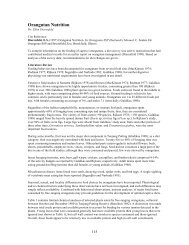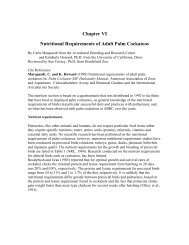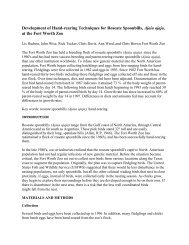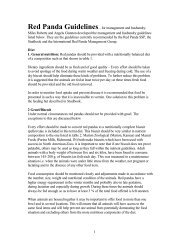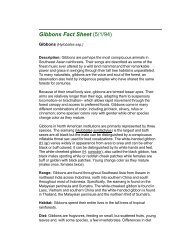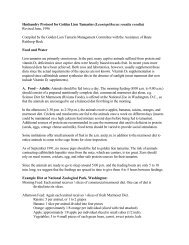Tree Kangaroo Nutrition Chapter - Nutrition Advisory Group
Tree Kangaroo Nutrition Chapter - Nutrition Advisory Group
Tree Kangaroo Nutrition Chapter - Nutrition Advisory Group
Create successful ePaper yourself
Turn your PDF publications into a flip-book with our unique Google optimized e-Paper software.
3.12 <strong>Tree</strong> <strong>Kangaroo</strong> Husbandry Manual<br />
BW (g)<br />
1800<br />
1600<br />
1400<br />
1200<br />
1000<br />
800<br />
600<br />
Figure 3.l: Zoological Society of San Diego Records - 1995. Mark Edwards . Ph.D.<br />
Collection of this type of data in relation to<br />
the animals' known age will ultimately allow<br />
the development of growth/age charts<br />
similar to those available for other<br />
marsupials.<br />
Early studies of marsupial milk composition<br />
clearly indicated that the composition differs<br />
from that of cow's milk (Bolliger and Pascoe<br />
1953). These variations in nutrient<br />
composition from those seen in placental<br />
mammals have been supported by further<br />
studies (Lemon and Barker 1967; Green et<br />
al. 1980). In general, the protein content of<br />
macropod milk tends to increase from<br />
approximately 3% at birth to 10% when the<br />
Figure 3.1. Growth of hand-reared male Goodfellow's <strong>Tree</strong> <strong>Kangaroo</strong><br />
400<br />
240 250 260 270 280 290 300 310 320 330 340<br />
days of age<br />
joey has left the pouch. The lipid fraction<br />
gradually increases from about 1.5% at birth<br />
to 10% when the joey is completely out of<br />
the pouch. The carbohydrate fraction is<br />
what makes marsupial milk truly unique.<br />
The concentration of carbohydrates<br />
increases from<br />
4% to 12% from birth to out of the pouch<br />
respectively.<br />
Due to the unique nutrient composition of<br />
marsupial milks, identifying a milk-replacer<br />
which approximates maternal milk has been<br />
problematic. A number of products have<br />
been used successfully by Australian zoos<br />
and wildlife rehabilitators, including:



